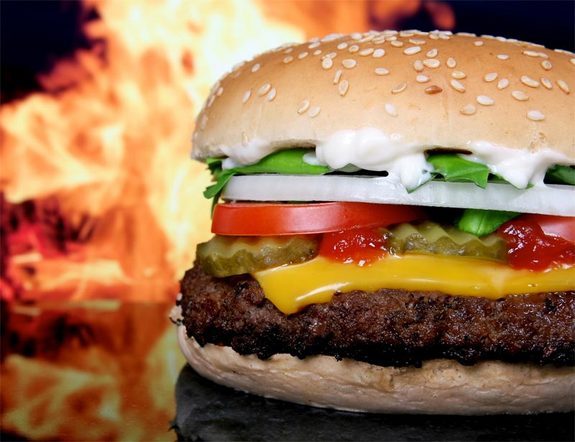Want to Save Earth? Cut Out Meat

Would you cut your meat consumption in half to help the climate? If you live in the developed world, that step may be necessary in order going to stabilize atmospheric levels of one potent greenhouse gas, nitrous oxide, new research shows.
Nitrous oxide is the biggest man-made contributor to stratospheric ozone destruction (the "ozone hole"), and the third most critical greenhouse gas after carbon dioxide and methane.
About 80 percent of nitrous oxide emissions from human activity come from agriculture. Bacteria convert the nitrogen found in manure or excess fertilizer left in the soil into nitrous oxide gas.
Every pound of meat we eat requires multiple pounds of grain to produce, and the grain in turn requires the use of nitrogen-containing fertilizer, so the amount of nitrous oxide released per calorie of meat (and dairy) is much higher than that from eating crops directly.
Eric Davidson of the Woods Hole Research Center looked at several possible trajectories for future nitrous oxide emissions, including stabilizing atmospheric nitrous oxide levels this century. He considered what changes to emissions would be necessary to achieve this target.
NEWS: Want to Live Longer? Hold the Red Meat
"I certainly did not set out to write a paper about dietary habits," he said of his new study, published in Environmental Research Letters
Sign up for the Live Science daily newsletter now
Get the world’s most fascinating discoveries delivered straight to your inbox.
One approach to reducing the amount of nitrous oxide emitted is to use nitrogen more efficiently for every pound of grain or meat produced. But reducing the demand for meat is also effective.
"To be comprehensive, I had to include scenarios that included meat consumption 'business as usual' and some that included reduced meat consumption," Davidson said.
"If we want to get to the most aggressive reduction -- the one that actually stabilizes nitrous oxide -- we have to use all of the above, including dietary changes, to get there," Davidson said.
His work showed that it would be necessary to reduce meat consumption in the developed world by 50 percent -- and to manage nitrogen twice as efficiently.
The analysis is consistent with what related work has shown, noted Christine Costello of Cornell University, pointing to a 2006 United Nations report stating that livestock contributes more to climate change than transport.
Costello noted that when you include methane -- released in large quantities by ruminants like cattle -- and carbon dioxide emissions from fertilizer production, the greenhouse gas emissions from agriculture and livestock are even larger.
NEWS: Why Cats, Other Carnivores Don't Taste Sweets
Nitrogen runoff from agriculture also causes the Gulf of Mexico dead zone and other eutrophication events in coastal waters, so reducing nitrogen emissions has additional benefits, Davidson and Costello noted.
Nitrous oxide is released in much smaller amounts than carbon dioxide and methane, but it is about 300 times better at trapping heat than carbon dioxide, and it lasts in the atmosphere for about 100 years, so each molecule packs a big climate warming punch.
But could such reductions in meat consumption ever happen? Davidson points out that 30 years ago, no one would have believed it possible that smoking would be banned in bars, yet that has come to pass.
According to Davidson's study, the average annual per capita consumption of meat in the developed world was 78 kilograms (171 pounds) in 2002 and is projected to grow to 89 kg (196 pounds) by 2030. Meanwhile, in the developing world it was 28 kg (62 pounds) in 2002, projected to grow to 37 kg (81 pounds) by 2030.
"We've been living in a very luxurious way. To go from 82 kg (180 pounds) of meat a year to 40 (88 pounds) doesn't seem like it should be so much to ask," Costello said.
This article was provided by Discovery News.










